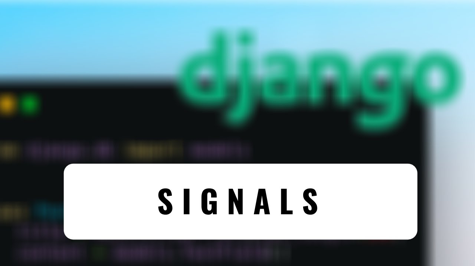Django is a popular web framework for building robust and scalable web applications. One powerful feature of Django is signals, which allow communication between different parts of your application in a decoupled manner. Signals provide a way to send and receive messages between different components of your Django application without them being tightly coupled, which can make your code more maintainable and flexible.
In this guide, we will demystify Django signals and provide a step-by-step tutorial with examples to help you understand how to use signals effectively in your Django projects.
What are Signals?
Signals in Django are a way to allow different parts of your application to communicate with each other in a decoupled manner. They provide a mechanism for sending and receiving messages, or "signals", between different components of your Django application. Signals are similar to the observer pattern, where one component sends a message (or signal) and one or more components receive and respond to that message.
Django signals are implemented using Python's built-in signal module, which allows you to define signals as senders and receivers. A signal is defined by a sender, which is the component that sends the signal, and a receiver, which is the component that receives and responds to the signal.
Signals are asynchronous, meaning they do not block the execution of the sender or receiver. When a signal is sent, it is simply added to a queue, and the sender continues to execute without waiting for the receivers to handle the signal. This allows for efficient communication between components of your application without affecting the performance of the sender or receiver.
Signals are also decoupled, meaning that the sender and receiver are unaware of each other's existence. The sender does not need to know which components are listening to the signal, and the receiver does not need to know which components are sending the signal. This loose coupling allows for greater flexibility and maintainability in your code.
Why Use Signals?
Signals can be a powerful tool in your Django projects for various reasons:
-
Decoupling of Components: Signals allow you to decouple different components of your application, making them independent of each other. This means that changes in one component do not directly affect other components, which can make your codebase more maintainable and easier to update. -
Flexibility: Signals provide a flexible way to communicate between different components of your Django application. You can add new receivers to a signal without modifying the sender, or you can change the behaviour of a receiver without modifying the sender. This allows for easy customization and extensibility of your application. -
Reusability:Signals allow you to reuse code by creating reusable signal handlers that can be attached to different signals. This can help reduce code duplication and promote modular and reusable code. -
Asynchronous Communication: Signals are asynchronous, which means that they do not block the execution of the sender or receiver. This can help improve the performance of your application by allowing components to communicate without waiting for each other to respond. -
Testing: Signals can be useful in testing scenarios where you must trigger events or actions based on certain conditions. You can use signals to simulate events in your tests, making it easier to write test cases for different scenarios.
Signal Terminology
Before we dive into the implementation of signals, let's clarify some common terminologies used in Django signals:
-
Signal:A signal is a notification that one or more senders emit and one or more receivers listen for. Signals are used to allow different parts of your Django application to communicate with each other in a decoupled manner. -
Sender: The sender is the component that sends the signal. It can be any Python object, such as a model, form, or view. -
Receiver:The receiver is the component that receives and responds to the signal. It can be any Python function or method that is decorated as a signal handler. -
Signal Handler: A signal handler is a Python function or method that is decorated with a@receiverdecorator, which specifies the signal to listen for and the action to perform when the signal is received.
Now that we understand the basic terminology, let's move on to implementing signals in Django step-by-step.
Step 1: Define a Signal
The first step in using Django signals is to define a signal. Signals are usually defined in the signals.py file of your Django app. Here's an example of how you can define a signal:
from django.dispatch import Signal
# Define a signal
my_signal = Signal(providing_args=["arg1", "arg2"])
In this example, we define a signal named my_signal using Django's Signal class. The providing_args argument is a list of arguments that the signal will pass to its receivers. In this case, the signal will provide two arguments: arg1 and arg2. You can customize this list of arguments based on your needs.
Step 2: Send a Signal
The next step is to send a signal from the sender. The sender can be any component in your Django application, such as a model, form, or view. Here's an example of how you can send a signal from a model's save method:
from django.dispatch import Signal
# Define a signal
my_signal = Signal(providing_args=["arg1", "arg2"])
class MyModel(models.Model):
# Model fields and methods
def save(self, *args, **kwargs):
# Do some actions before saving
# Send the signal
my_signal.send(sender=self.__class__, arg1=self.field1, arg2=self.field2)
# Call the original save method
super(MyModel, self).save(*args, **kwargs)
In this example, we send the my_signal signal from the save method of a model named MyModel. The sender argument is set to self.__class__, which is the class of the sender. We also pass the values of field1 and field2 as arguments to the signal using the arg1 and arg2 parameters.
Step 3: Receive a Signal
The next step is to receive and handle the signal in a receiver. Receivers are Python functions or methods that are decorated with the @receiver decorator, which specifies the signal to listen for and the action to perform when the signal is received. Here's an example of how you can define a signal handler:
from django.dispatch import Signal, receiver
# Define a signal
my_signal = Signal(providing_args=["arg1", "arg2"])
# Signal handler
@receiver(my_signal)
def my_signal_handler(sender, arg1, arg2, **kwargs):
# Handle the signal
print("Signal received from sender:", sender)
print("arg1:", arg1)
print("arg2:", arg2)
# Perform actions based on the signal
# ...
In this example, we define a signal handler named my_signal_handler using the @receiver decorator. The decorator specifies the my_signal signal to listen for. The sender argument in the signal handler represents the sender that emitted the signal. The arg1 and arg2 arguments in the signal handler represent the arguments passed to the signal when it was sent, and **kwargs allows you to capture any additional keyword arguments that may be passed to the signal.
Step 4: Connect the Signal
In order for Django to recognize and process your signal, you need to connect it. This is typically done in the apps.py file of your Django app. Here's an example of how you can connect the my_signal signal:
from django.apps import AppConfig
class MyAppConfig(AppConfig):
name = 'myapp'
def ready(self):
# Import the signal handlers
import myapp.signals
In this example, we import the myapp.signals module, which contains the definition of the my_signal signal. The ready method of the MyAppConfig class is automatically called by Django when the app is loaded, and this is where you should connect your signals.
Step 5: Disconnect the Signal (optional)
If you want to disconnect a signal at a later point, you can use the disconnect method of the Signal class. Here's an example of how you can disconnect the my_signal signal:
from myapp.signals import my_signal
# Disconnect the signal
my_signal.disconnect(my_signal_handler)
In this example, we use the disconnect method of the my_signal signal and pass the signal handler function my_signal_handler as an argument to disconnect it. Note that you need to pass the exact same function that was used to connect the signal.
Step 6: Sending Signals with send_robust
By default, Django signals are sent using the send method of the signal, which sends the signal to all registered receivers and waits for them to complete it before continuing. However, in some cases, you may want to send signals in a non-blocking manner, so that the sender does not have to wait for the receivers to complete. For this, Django provides the send_robust method. Here's an example of how you can use the send_robust method:
from myapp.signals import my_signal
# Send the signal using send_robust
my_signal.send_robust(sender=self.__class__, arg1=self.field1, arg2=self.field2)
In this example, we use the send_robust method of the my_signal signal to send the signal in a non-blocking manner. The sender does not wait for the receivers to complete and continues execution immediately after sending the signal.
Step 7: Best Practices
Here are some best practices to keep in mind when using Django signals:
-
Keep signal handlers simple: Signal handlers should be kept simple and should not contain complex logic or long-running tasks. They should perform their intended action quickly and return. If you need to perform complex tasks or time-consuming operations, consider using a task queue or a separate background process.
-
Use signals sparingly: Signals can be a powerful tool for decoupling components in your Django application, but they can also make your code harder to understand and debug if used excessively. Use signals only when they provide a clear benefit and avoid using them for trivial or unnecessary actions.
-
Document your signals: Signals can be used by different developers in different parts of your Django application, so it's important to document your signals properly. Provide clear documentation on how to connect, disconnect, and use your signals, including any arguments they provide and any expected return values.
-
Test your signals: As with any other part of your Django application, it's important to thoroughly test your signals to ensure they are working as expected. Write test cases that cover different scenarios and edge cases, and regularly run your tests to catch any potential issues.
-
Follow naming conventions: Django signals are global, so it's important to choose descriptive and unique names for your signals to avoid clashes with signals defined in other apps or third-party libraries. It's common practice to prefix the signal name with the name of the app or module that defines it, followed by an underscore and a descriptive name. For example,
myapp_mysignal. -
Consider using Django's built-in signals: Django provides several built-in signals that you can use in your application, such as
pre_save,post_save,pre_delete,post_delete, etc. These signals are triggered automatically by Django when certain actions are performed, such as saving or deleting an object, and can be used to perform additional tasks or validations.
Conclusion
Django signals are a powerful tool that allows different parts of your application to communicate with each other in a decoupled manner. They provide a way to send and receive notifications when certain events occur in your Django application and can be used to trigger actions or perform validations. By following the steps outlined in this guide, you can easily implement and use Django signals in your application. Remember to keep your signal handlers simple, use signals sparingly, document your signals, test them thoroughly, follow naming conventions, and consider using Django's built-in signals for common use cases. With proper usage, Django signals can greatly improve the modularity and maintainability of your codebase.





